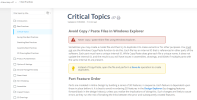I'm trying to figure out my workflow with Alibre, as I've discovered I have a tendency to write over old versions and thus lose prior work when fiddling with dials and adjusting fit of certain designs. How do you all manage your workflows and designs?
I'm coming from Fusion360 which automatically versioned each save and let me roll back. Is that feature available or do I need to do something like manual git snapshots?
Looking forward to hearing how others achieve this or how the software supports this workflow.
Thanks!
I'm coming from Fusion360 which automatically versioned each save and let me roll back. Is that feature available or do I need to do something like manual git snapshots?
Looking forward to hearing how others achieve this or how the software supports this workflow.
Thanks!

